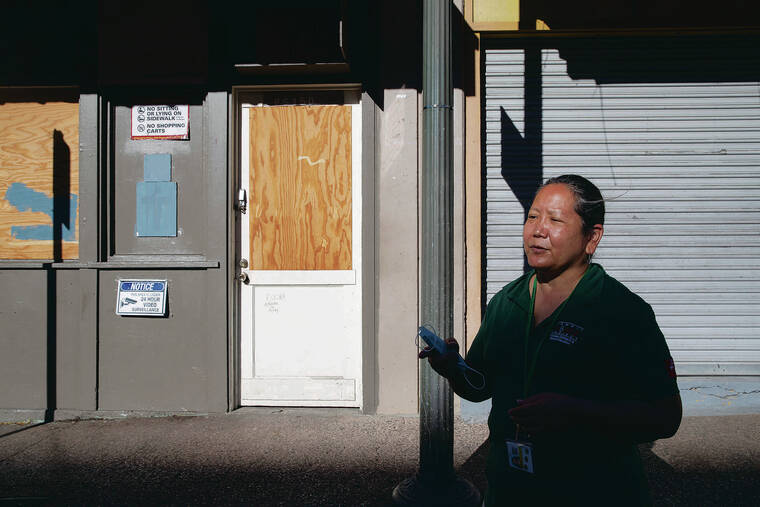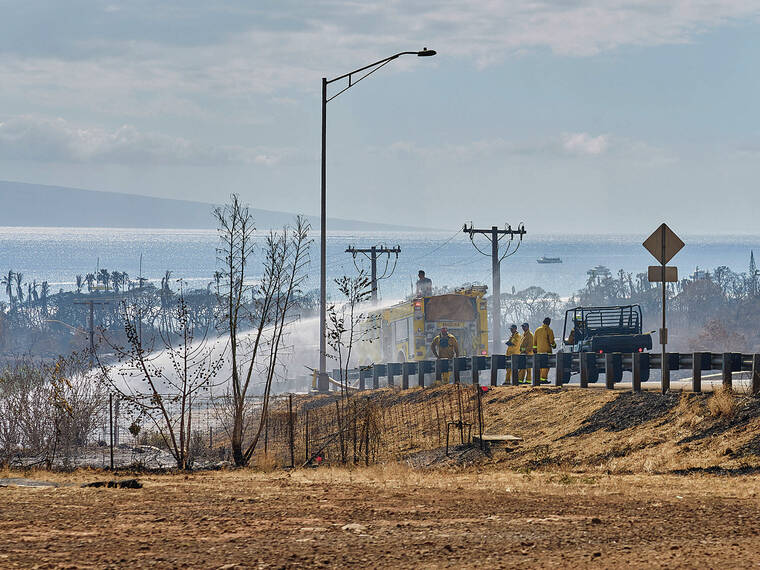City to open free wound clinic to address needs of homeless on Oahu

CINDY ELLEN RUSSELL / CRUSSELL@STARADVERTISER.COM
The city, in partnership with the John A. Burns School of Medicine, is opening a new wound care center in Chinatown for people who are homeless. Dr. Jill Omori, director of the Hawaii Home Project, is seen at the site, 150 N. Pauahi St.
The city plans to open a free wound-care clinic in Chinatown in November to primarily serve the homeless. The clinic would be the first official collaboration between the city and the University of Hawaii John A. Burns School of Medicine’s Homeless Outreach &Medical Education, or H.O.M.E., program.
The H.O.M.E. program was started in 2006 by Dr. Jill Omori to serve the homeless and provide training opportunities to medical and nursing students. It has 10 locations around the island, offering basic wound care, preventive care and some mental health services.
Omori is executive director of the H.O.M.E. program and a professor at JABSOM. While still a medical student, she had a passion for providing care to underserved patients but noticed there weren’t many training opportunities available at the time.
“When I became faculty, it was one of the things I kind of wanted to infuse into the curriculum,” Omori said. “I first started on the education side of things, just kind of getting some grants to work on curriculum for the medical students for underserved care. And then out of that came the clinics. … I felt like the school wasn’t doing enough outreach to the community, providing enough service … so it was a way for us to provide that service but also to provide an educational experience for the students.”
Currently, H.O.M.E. operates twice a week out of the Joint Operation Center next to the Honolulu Police Department substation in Chinatown, but its new location on Pauahi Street would be permanent, starting out at least five days a week and ramping up from there.
Omori emphasized the value of providing consistent care for patients who lack shelter.
Don't miss out on what's happening!
Stay in touch with breaking news, as it happens, conveniently in your email inbox. It's FREE!
“We can provide more consistent daily care for this community,” she said. “They’re not going to remember when they have appointments and things like that, and as long as they can just drop in, they know where we are and they know they can drop in anytime to get the services, then I think they’re more likely to come by for medical care.”
One of the added benefits of opening the clinic in Chinatown is that it will be across the street from the city’s Crisis Outreach Response and Engagement headquarters. CORE is a program within the Emergency Medical Services Division that uses a special team of first responders to address nonviolent emergency calls involving the homeless.
EMS Director Jim Ireland said CORE works with H.O.M.E. unofficially, bringing in patients or assisting with transporting those seeking care at H.O.M.E. to the hospital when needed.
“We want to take it to another level where we’re really working together, hopefully on a daily basis,” he said.
“This clinic that we’re trying to do with H.O.M.E. is really focused on the homeless population who don’t get medical care, or they use 911 to get all their medical care through the (emergency rooms),” Ireland said. “If it’s an emergency, that’s fine, but the vast majority of these are not emergencies, it’s wound care, ‘I ran out of medicine,’ minor psychiatric problems like anxiety or mild depression.”
He hopes the H.O.M.E. clinic combined with CORE will be able to relieve some of the burden on overloaded hospitals, adding that some homeless people call 911 for assistance 50 to 100 times a year.
Since CORE started service in October, it has housed about 30 people, Ireland said.
The H.O.M.E. clinic’s location on Pauahi Street is a vacant city-owned building. Ireland said that at one point there were maybe two liquor stores utilizing the space, but the community did not want that type of establishment to remain. Instead, he hopes the new clinic will become a place where people can go for care before being taken to a shelter or the Homeless Outreach and Navigation for Unsheltered Persons, or HONU, triage shelter made up of tents to help transition people off the street and into more stable housing.
“We want this to be a clinic where people come and go — we bring people there, and then when they’re done at the clinic, we take them to an appropriate shelter, or HONU or housing, but we don’t want that to be a gathering place, basically Pauahi Street, for people who are houseless,” Ireland said.
Shelter space is one of the trickier elements of the H.O.M.E. program. Omori said it’s often difficult to place homeless patients in shelters, even when they are willing.
“There’s been so many times that our patients are wanting to go into a shelter and they just, for some reason, they either don’t qualify or it’s closed, there’s not openings, and so then they have to wait,” she said.
“We can tell them to try to come back the next time, but we don’t know where they’re going to be, necessarily. And so unless we can get them in, like, that day, it’s really hard.”
Some patients have been hesitant to go to HONU because of its location on Middle Street, which may be seen as not centrally located. And because it is staffed with police officers, some patients do not feel comfortable relocating there. She added that the tents can get hot, and for that reason patients might prefer their current situation on the street.
Omori hopes the city could build out a space within the clinic for medical respite, where someone could stay overnight or for a few days to get consistent care. She said it’s nearly impossible now to get their patients into medical respite to help their recovery.
“There’s so many times where we feel that there’s patients that have medical problems, and if they just had a stable place to stay and somebody to help them with basic medical needs … we could prevent them from going to the emergency room, we can prevent them from being admitted,” she said.
“Right now there’s nowhere we can send them, so that’s why we want to utilize that space for that.”
She would like the city to pitch in with overnight staffing for respite patients while H.O.M.E. provides medical services during the day.
Ireland agrees that increasing shelter space is critical to decreasing homelessness on Oahu and making the program work. He said a city-run shelter is not off the table and that officials meet every Thursday to discuss homelessness, shelter space being a key topic.
The No. 1 priority, he said, is creating more shelter space, either by partnering with nonprofits or even having a city-run shelter.
“That may involve a nonprofit, such as the (Institute for Human Services), who’s already doing a great job, other nonprofits or literally a city-owned and run shelter to increase capacity,” Ireland said.
Other proposals include expanding the kauhale concept, or small-house villages, and potentially utilizing the State Hospital facility, which will be vacant in the next two months, to increase mental health treatment services.




